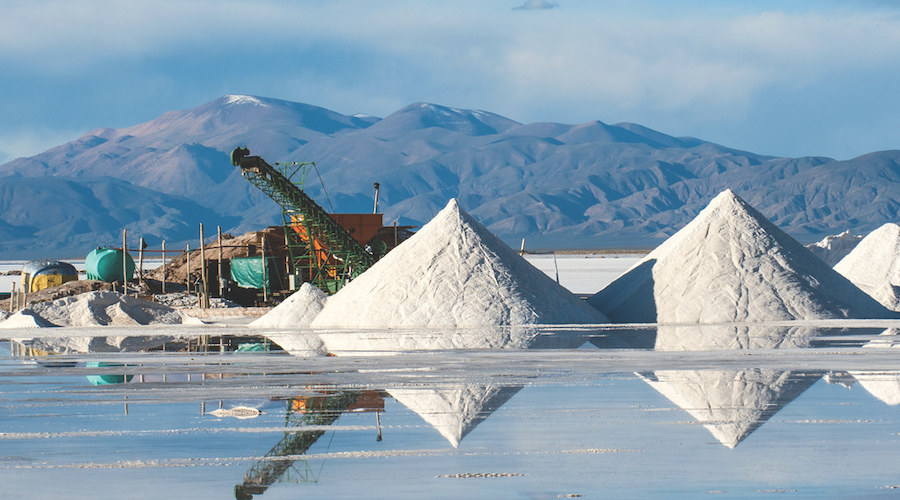Staff Writer | April 18, 2023 |

Lithium mine on the Salinas Grandes salt flat Jujuy province, Argentina.
(Image by Earthwork, Flickr.)
An expected surge in demand for battery-grade lithium, nickel, cobalt, manganese and platinum is set to create a variety of economic and supply-chain problems, according to new research out of Cornell University.

In a paper published in the journal Nature Communications, senior author Fengqi You and his colleagues examined 48 countries that are committed to playing a strong role in electrifying transportation, including the US, China and India.
Under a scenario where 40% of vehicles are electric by 2050, the need for lithium globally will increase by 2,909% from the 2020 level. If 100% of vehicles are electric by 2050, the need for lithium more than doubles to 7,513%.
From the years 2010 to 2050, in a scenario where all vehicles are electric, the annual demand for lithium would increase globally from 747 metric tons to 2.2 million metric tons.
By mid-century, for example, the demand for nickel eclipses other critical metals, as the global need ranges from 2 million metric tons, where 40% of vehicles are electric, to 5.2 million metric tons where all vehicles are electric.
The paper also notes that the annual demand for cobalt (ranging from 0.3 to 0.8 million metric tons) and manganese (ranging from 0.2 to 0.5 million metric tons) is expected to rise by the same order of magnitude in 2050.
“The unstable supplies of critical metals and minerals can exacerbate supply risks under surging demand,” You said, pointing to World Bank data that show that currently, critical metals and minerals are centralized in politically unstable countries such as Chile, Congo, Indonesia, Brazil, Argentina and South Africa.
Given this forecast, the researchers urge caution on the electrification of heavy-duty vehicles, which require more critical metals than other vehicles. Although they account for only between 4% and 11% of the total road fleet in some countries, battery-related critical metals used in heavy-duty electric vehicles will account for 62% of the critical metal demand in the decades ahead.
In their view, building a circular economy would be indispensable if it achieved a closed-loop supply chain of critical metals in the future. Thus, a number of strategies should be considered to promote the recycling efficiency and recovery rate of end-of-life batteries at a proper pace.
They also suggest that countries should adopt policies that prioritize alternative designs for cathodes/anodes and fuel-cell systems to reduce the reliance on primary critical metals.
Finally, the Cornell group proposes that decarbonization targets for road transportation should consider not only electric vehicle deployment but also the timing of carbon peak and neutrality, and accurate emission budgets.
An expected surge in demand for battery-grade lithium, nickel, cobalt, manganese and platinum is set to create a variety of economic and supply-chain problems, according to new research out of Cornell University.

In a paper published in the journal Nature Communications, senior author Fengqi You and his colleagues examined 48 countries that are committed to playing a strong role in electrifying transportation, including the US, China and India.
Under a scenario where 40% of vehicles are electric by 2050, the need for lithium globally will increase by 2,909% from the 2020 level. If 100% of vehicles are electric by 2050, the need for lithium more than doubles to 7,513%.
From the years 2010 to 2050, in a scenario where all vehicles are electric, the annual demand for lithium would increase globally from 747 metric tons to 2.2 million metric tons.
By mid-century, for example, the demand for nickel eclipses other critical metals, as the global need ranges from 2 million metric tons, where 40% of vehicles are electric, to 5.2 million metric tons where all vehicles are electric.
The paper also notes that the annual demand for cobalt (ranging from 0.3 to 0.8 million metric tons) and manganese (ranging from 0.2 to 0.5 million metric tons) is expected to rise by the same order of magnitude in 2050.
“The unstable supplies of critical metals and minerals can exacerbate supply risks under surging demand,” You said, pointing to World Bank data that show that currently, critical metals and minerals are centralized in politically unstable countries such as Chile, Congo, Indonesia, Brazil, Argentina and South Africa.
Given this forecast, the researchers urge caution on the electrification of heavy-duty vehicles, which require more critical metals than other vehicles. Although they account for only between 4% and 11% of the total road fleet in some countries, battery-related critical metals used in heavy-duty electric vehicles will account for 62% of the critical metal demand in the decades ahead.
In their view, building a circular economy would be indispensable if it achieved a closed-loop supply chain of critical metals in the future. Thus, a number of strategies should be considered to promote the recycling efficiency and recovery rate of end-of-life batteries at a proper pace.
They also suggest that countries should adopt policies that prioritize alternative designs for cathodes/anodes and fuel-cell systems to reduce the reliance on primary critical metals.
Finally, the Cornell group proposes that decarbonization targets for road transportation should consider not only electric vehicle deployment but also the timing of carbon peak and neutrality, and accurate emission budgets.
No comments:
Post a Comment